Production of Pokémon animation: Difference between revisions
mNo edit summary Tag: Reverted |
m (→Localization) |
||
| (16 intermediate revisions by 8 users not shown) | |||
| Line 1: | Line 1: | ||
The [[Pokémon]] franchise has produced numerous [[Pokémon animation|animated works]], most notably the mainline {{pkmn|animated series}}, consisting of ''[[Pokémon the Series]]'' and its successor ''[[Pokémon Horizons: The Series]]''. | |||
Other notable works include the [[Pokémon movie]]s, a few [[List of animated series specials|standalone specials]], the {{wp|Computer-generated imagery|CGI}} elements of the live-action film {{DetPikMov}}, and several mini-series. There is also a wide assortment of short-form content, including various web shorts, trailers, commercials, music videos, and promotional videos. | |||
Several common systems, processes, and components are used in the making of Pokémon animation. | |||
==Overview== | |||
<!--{{cleanup|section|needs additional citations for verification}}--> | |||
===Main series and movies=== | |||
[[File:Early anime film frame.png|thumb|250px|A cel from the [[original series]]]] | |||
The [[Pokémon animated series]] and their tie-in media are primarily produced in {{pmin|Japan}} by the animation studio [[OLM, Inc.|OLM]]. Until the [[S05|fifth season]] episode ''[[EP259|A Crowning Achievement]]'', the series was animated using {{wp|cel animation}}; from ''[[EP260|Here's Lookin' at You Elekid!]]'' onwards, all episodes are digitally animated. [[TV Tokyo]], {{jwp|テレビ東京メディアネット|MEDIANET}}, and {{wp|Shogakukan-Shueisha Productions|ShoPro}} are the executive producers for the series, while the Pikachu Project is the {{jwp|製作委員会方式|production committee}} for the movies. The copyright for the series and movies are held jointly by [[Nintendo]], [[Creatures, Inc.|Creatures]], [[Game Freak]], TV Tokyo, ShoPro, and [[JR Kikaku]]. In 2001, an average episode cost approximately US$100,000 to produce.<ref>Rutenberg, Jim (January 28, 2001). [https://www.nytimes.com/2001/01/28/us/violence-finds-a-niche-in-children-s-cartoons.html "Violence Finds a Niche in Children's Cartoons"]. ''The New York Times''. [https://web.archive.org/web/20211224120105/https://www.nytimes.com/2001/01/28/us/violence-finds-a-niche-in-children-s-cartoons.html Archived] from the original on December 24, 2021. Retrieved January 22, 2024.</ref> | |||
In the West, [[The Pokémon Company International]] (TPCi) currently oversees production and distribution of the series in partnership with [[Iyuno]], with lines for the English dub also being recorded at {{wp|Goldcrest Films|Goldcrest Post}} and Okratron 5000.<ref>[[Lisa Ortiz|Ortiz, Lisa]] (June 12, 2020). [https://www.pokemon.com/us/pokemon-episodes/23_01-enter-pikachu/ "Enter Pikachu!"]. ''[[Pokémon Journeys: The Series]]''. [[S23|Season 23]]. [[JN001|Episode 1]]. [[Netflix]]. [https://web.archive.org/web/20220214155321/https://www.pokemon.com/us/pokemon-episodes/23_01-enter-pikachu/ Archived] from the original on February 14, 2022. Retrieved January 22, 2024.</ref> [[4Kids Entertainment]] initially licensed the series in {{pmin|the United States}},<ref>[https://yahoo.brand.edgar-online.com/displayfilinginfo.aspx?FilingID=498210-1238-105389&type=sect&TabIndex=2&companyid=2289&ppu=%252fdefault.aspx%253fcompanyid%253d2289 "10-K"]. Yahoo. March 31, 1999. p. 6. [https://web.archive.org/web/20161005043926/http://yahoo.brand.edgar-online.com/displayfilinginfo.aspx?FilingID=498210-1238-105389&type=sect&TabIndex=2&companyid=2289&ppu=%252fdefault.aspx%253fcompanyid%253d2289 Archived] from the original on October 5, 2016. Retrieved January 22, 2024.</ref> producing the [[Dub|English dub]] in conjunction with [[TAJ Productions]] from seasons [[S01|one]] to [[S05|five]]. 4Kids was then the sole producer from seasons [[S06|six]] to [[S08|eight]], after which the show was produced by TPCi (then known as Pokémon USA) and TAJ Productions for seasons [[S09|nine]] and [[S10|ten]]. From seasons [[S11|eleven]] through [[S22|twenty-two]], the dub was produced by TPCi with {{wp|DuArt Film and Video}}. Since the beginning of the [[S23|twenty-third season]], the dub is produced by TPCi with Iyuno.<ref>[[Lisa Ortiz|Ortiz, Lisa]] (June 12, 2020). [https://www.pokemon.com/us/pokemon-episodes/23_01-enter-pikachu/ "Enter Pikachu!"]. ''[[Pokémon Journeys: The Series]]''. [[S23|Season 23]]. [[JN001|Episode 1]]. [[Netflix]]. [https://web.archive.org/web/20220214155321/https://www.pokemon.com/us/pokemon-episodes/23_01-enter-pikachu/ Archived] from the original on February 14, 2022. Retrieved January 22, 2024.</ref> | |||
| | |||
In 2018, the creators of the live-action film {{DetPikMov}}, which features the titular {{pkmn2|talking}} {{OBP|Detective Pikachu|character}}, revealed that the original intention for ''Pokémon the Series'' was to have the Pokémon talk, but OLM faced challenges in developing a concept that [[Game Freak]] would approve.<ref>[https://www.youtube.com/watch?v=NmsZtdTYTVo "5 Detective Pikachu Facts From Our Developer Interview! (What's New, Movie, & Origin)"]. ''YouTube''. March 5, 2018. [https://ghostarchive.org/varchive/youtube/20211221/NmsZtdTYTVo Archived] from the original on December 21, 2021. Retrieved January 22, 2024.</ref> | |||
{ | The [[Pokémon movie]]s are primarily produced by OLM, with {{wp|Wit Studio}} and {{wp|Sprite Animation Studios}} being credited as co-producers for ''[[M21|The Power of Us]]'' and ''[[M23|Mewtwo Strikes Back—Evolution]]'', respectively. The twenty-second movie, ''[[M22|Pokémon: Mewtwo Strikes Back—Evolution]]'', is a {{wp|Computer animation|computer-animated}} remake of the [[M01|first movie]]. | ||
| | |||
===Other works=== | |||
Various computer-animated trailers, commercials, and [[YouTube]] shorts have been produced by [[Creatures, Inc.]] | |||
OLM, {{wp|Production I.G}}, and {{wp|Xebec (studio)|Xebec}} produced the [[Pokémon Origins]] animated series. | |||
Additionally, | Additionally, [[Pokémon Concierge]] is a 2023 {{wp|Stop motion|stop-motion}} animated series produced by [https://dw-f.jp/english/ dwarf studios] as a collaborative production between [[Netflix]] and [[The Pokémon Company]]. | ||
==Animation process== | |||
The animation process for Pokémon largely involves the use of reference materials, model sheets, and the storyboarding process, as well as occasionally relying on recycled animation. | |||
===Reference materials=== | |||
Detailed reference materials, also known as '''{{wp|Setting (narrative)|setting}} materials''' (Japanese: '''{{jwp|設定 (物語)|設定}}''' ''settei'', lit. "setting materials"), and sometimes referred to as '''{{wp|model sheet}}s''' or '''concept art''' depending on usage and context, depict designs, objects, and locations from a variety of angles. This material is given to artists in order to create consistent and accurate works, which is integral for both 2D and 3D artists alike.<ref name=SakugaBooruTags></ref><ref name=SakugaBooruTagModelSheet>[https://sakugabooru.com/post?tags=settei+ SakugaBooru tag showing various model sheets drawn by animation staff.]</ref> | |||
== | ===Model sheets=== | ||
In model sheets for animated productions, where flat colors are used, the color of each line or filled material represents a different intent when the artwork is to be colored, further providing the artist using the model sheets with additional context to aid their work. | |||
* '''Black lines''' are used for lines that are not meant to disappear when colored. | |||
''' | * '''<span style="color:#f46b65">Red</span> lines''' are often, though not always, used for specific particular color fills, such as highlights from exterior lighting within a scene whenever applicable. | ||
* '''<span style="color:#88a6fc">Blue</span> lines''' best denote a division between a dark and light area, used for shadows. They're invisible when the figure has been fully painted or colored. | |||
* '''<span style="color:#000000; background:#70df90">Green</span>''' or '''<span style="color:#000000; background:#9aebec">blue</span> fills''' are used for shadowed areas. | |||
* '''<span style="color:#000000; background:#fffdbc">Yellow</span> fills''' denote areas that serve as highlights. | |||
{| style="margin:auto; text-align:center; {{roundy| | {| style="margin:auto; text-align:center; {{roundy|2px}} border:2px solid #{{white color dark}}; background:#{{white color}}; font-size:80%" | ||
|- | |- | ||
| style="{{roundy| | | style="{{roundy|2px}} border:2px solid #{{white color dark}}; background:#{{white color light}}" | [[File:M12 Arceus concept art comparison.png|x300px]] | ||
| style="{{roundy| | | style="{{roundy|2px}} border:2px solid #{{white color dark}}; background:#{{white color light}}" | [[File:Iono anime expression sheet.png|x300px]] | ||
|- | |- | ||
| | | A comparison of two poses from different model sheets<br> of {{color2|000|Arceus (M12)|Arceus}} from ''{{color2|000|M12|Pokémon: Arceus and the Jewel of Life}}''<br>to best illustrate the purpose of differently colored lines and filled areas | ||
| | | {{color2|000|Iono}}'s model sheets from ''{{color2|000|Pokémon Horizons: The Series}}'' | ||
|} | |} | ||
===Storyboarding=== | |||
[[File:Evolutions E07 Storyboard.jpg|thumb|left|200px|Part of a storyboard from ''[[PE07|The Show]]'' in [[Pokémon Evolutions]] depicting a [[Kimono Girl]] and her {{p|Espeon}}, drawn by [[Tetsuya Wakano]]]] | |||
[[File:SME107 Storyboard.jpg|thumb|right|250px|Part of a storyboard from ''[[SM107|Run, Heroes, Run!]]'' in ''[[Pokémon the Series: Sun & Moon]]'', drawn by [[Masaaki Iwane]]<ref name=SM89Storyboard>[https://web.archive.org/web/20231213034153/https://twitter.com/you_director/status/1091922667941163008?t=87IbncVfI7kxhRKpakknPQ Storyboard drawn by Masaaki Iwane, posted by Yuji Asada]</ref>]] | |||
'''{{wp|Storyboard}}s''' (Japanese: '''{{jwp|絵コンテ}}''' ''e-konte'', lit. "drawing continuity") are one of the earliest types of minimal production materials used for various media to allow artists to better visualize scenes that are going to be developed further, typically by background artists, modelers, animators, or a compositing team.<ref name=SakugaBooruTags></ref><ref name=SakugaBlog>[https://blog.sakugabooru.com/glossary/ Sakugablog's glossary, which contains a variety of references from the most prominent JP animation community online]</ref> They often, though not always, come after model sheets in the production line. This part of Japanese productions involves a sequenced series of storyboards that include specific details to assist with the process further down the production line, including planned dialogue and acting instructions.<ref name=SakugaBooruTagStoryboards>[https://sakugabooru.com/post?tags=storyboard SakugaBooru tag showing various storyboards drawn by animation staff.]</ref> | |||
{| style="margin:auto; text-align:center; {{roundy|2px}} border:2px solid #{{white color dark}}; background:#{{white color}}; font-size:80%" | |||
{| style="margin:auto; text-align:center; {{roundy| | |||
|- | |- | ||
| style="{{roundy| | | style="{{roundy|2px}} border:2px solid #{{white color dark}}; background:#{{white color light}}" | [[File:Horizons E12 Storyboard-1.jpg|x220px]] | ||
| style="{{roundy| | | style="{{roundy|2px}} border:2px solid #{{white color dark}}; background:#{{white color light}}" | [[File:Path to the Peak E02 Storyboard-1.png|x220px]] | ||
|- | |- | ||
| | | colspan=2 | Storyboards from {{color2|000|HZ012}} in ''{{color2|000|Pokémon Horizons: The Series}}'', by {{color2|000|Yoshikazu Miyao}}, and from ''{{color2|000|Regionals}}'' in {{color2|000|Pokémon: Path to the Peak}}, by {{color2|000|Kiana Khansmith}} <ref name=KianaMaiPTTPBoards>[https://web.archive.org/web/20231213033103/https://twitter.com/kianamaiart/status/1692241395258646910 Kiana Khansmith's Path to the Peak storyboards.]</ref> | ||
| {{color2|000| | |||
|} | |} | ||
{{-}} | |||
The next step of the storyboarding process involves creating a '''layout'''.<ref name=SakugaBooruTags></ref><ref name=SakugaBlog></ref> Now that a cut or scene has been planned out, it is up to the job of an animator to create a layout that acts as the skeleton of the scene, for artists to follow when further down in the production line. These often feature more intense detail, depth, and perspective than the initial storyboard. When compiled, layouts are often animated with rudimentary motion of specific parts in order to aid animators in the next step.<ref name=SakugaBooruTagLayout>[https://sakugabooru.com/post?tags=layout+ SakugaBooru tag showing various layouts drawn by animation staff.]</ref> | |||
Animators may also create an '''animatic''', a sort of animated storyboard, typically with an early soundtrack or vocals, to help visualize a scene before it is fully animated.<ref name=Animatic>[https://web.archive.org/web/20231213032757/https://www.studiobinder.com/blog/what-is-an-animatic-definition/ What is an Animatic — How To Bring Your Storyboard to Life]. Brent Dunham, studiobinder.</ref> | |||
{| style="margin:auto; text-align:center; {{roundy|2px}} border:2px solid #{{white color dark}}; background:#{{white color}}; font-size:80%" | {| style="margin:auto; text-align:center; {{roundy|2px}} border:2px solid #{{white color dark}}; background:#{{white color}}; font-size:80%" | ||
|- | |- | ||
| style="{{roundy|2px}} border:2px solid #{{white color dark}}; background:#{{white color light}} | | style="{{roundy|2px}} border:2px solid #{{white color dark}}; background:#{{white color light}}" | [[File:PE06 Layout.png|x250px]] | ||
|- | |- | ||
| | | Layout from ''{{color2|000|PE06|The Wish}}'' in {{color2|000|Pokémon Evolutions}} | ||
|} | |} | ||
After the layout phase,<ref name=SakugaBlog/> '''{{wp|key frame}}s''' (Japanese: '''{{jwp|原画}}''' ''genga'', lit. "original pictures")<ref name=ANNCreditsFeature>[https://www.animenewsnetwork.com/feature/2016-03-16/your-ultimate-guide-to-anime-ending-credits-part-i/.99852 Your Ultimate Guide to Anime Ending Credits: Part I -- by Kevin Cirugeda, ANN.]</ref> are used to define the motion within a cut of animation drawn by the key animator. They are often corrected by those higher up on the production team, such as animation directors<ref name=HiroyukiKitakobo>[https://web.archive.org/web/20231213031949/https://twitter.com/LawofGreen/status/768781927100747777 Animator Hiroyuki Kitakobo referencing early use of the term Animation Director at Studio BONES.]</ref> (also referred to as animation supervisors),<ref name=ANNCreditsFeature></ref> chief animation directors, or character designers.<ref name=SakugaBooruTags></ref> They are then traced by '''in-between''' (Japanese: '''動画''' ''dōga'', lit. "moving pictures")<ref name=ANNCreditsFeature></ref> artists, who also draw the missing frames following the notes left by the key animator for timing and frame-pacing. | |||
Occasionally, this production material is released officially,<ref name=KeyFrameHZ31>[https://web.archive.org/web/20231213032543/https://twitter.com/anipoke_PR/status/1730104372208730289 upload of key frame for episode 31 of ''Pokémon Horizons: The Series'' by the Japanese AniPoké Twitter account.]</ref><ref name=KeyFrameHZ32>[https://web.archive.org/web/20231213032621/https://twitter.com/anipoke_PR/status/1732641086424973703 upload of key frame for episode 32 of ''Pokémon Horizons: The Series'' by the Japanese AniPoké Twitter account.]</ref> and in some instances, by staff on the series after their work has been completed. | |||
As can be seen below, the color of each line or filled material represents a different intent when the artwork is to be colored. It shares these colors and their definitions with those used for [[#Model sheets|model sheets]]. | |||
{| style="margin:auto; text-align:center; {{roundy|2px}} border:2px solid #{{white color dark}}; background:#{{white color}}; font-size:80%" | {| style="margin:auto; text-align:center; {{roundy|2px}} border:2px solid #{{white color dark}}; background:#{{white color}}; font-size:80%" | ||
|- | |- | ||
| style="{{roundy|2px}} border:2px solid #{{ | | style="{{roundy|2px}} border:2px solid #{{electric color dark}}; background:#{{white color light}}" | [[File:HZ Genga E015.jpg|x250px]] | ||
| style="{{roundy|2px}} border:2px solid #{{electric color dark}}; background:#{{white color light}}" | [[File:Iono Horizons.jpg|x250px]] | |||
| style="{{roundy|2px}} border:2px solid #{{ | |||
|- | |- | ||
| | | Key frame from {{color2|000|HZ015}} in ''{{color2|000|Pokémon Horizons: The Series}}''<br>by {{color2|000|Masaaki Iwane}}<ref name=IwaneSoloAnimate>[https://web.archive.org/web/20230905123110/https://fullfrontal.moe/nakano/ Interview with Satoshi Nakano explaining that Iwane is still a solo-animator.]</ref> | ||
| | | The finished scene in {{color2|000|HZ015}} | ||
| | |||
|} | |} | ||
''A list of key frames uploaded to Bulbapedia can be found '''[[a:Category:Key frames|here]].''''' | |||
===Recycled animation=== | |||
[[File:Anime Rocket Trio Mecha Reticle concept art.png|thumb|200px|Reference materials showing the reticle for a Team Rocket mecha in the [[original series]], denoted as BANK]] | |||
The '''bank system''' (Japanese: '''{{jwp|バンクシステム}}''' ''bank system''), also known as '''BANK animation''' or just '''BANK''', is a specific Japanese technique derived from {{wp|limited animation}}, wherein animation is re-used in part or in whole in a 2D animated production,<ref>[https://www.researchgate.net/publication/342551066_The_Ritualization_of_the_Bank_System_in_Japanese_TV_Animation_with_Hero_or_Heroine (PDF) The Ritualization of the "Bank System" in Japanese TV Animation with Hero or Heroine]</ref><ref name=IwaneCitation>[https://web.archive.org/web/20231211153755/https://twitter.com/animator1965/status/1405885886345093131 Pokémon animator Masaaki Iwane defining the term BANK on Twitter.]</ref><ref name=IwaneCitationMarshmallow>[https://web.archive.org/web/20231211153930/https://marshmallow-qa.com/messages/421946cc-cd25-4eaf-bbb6-3e572000f473?utm_medium=twitter&utm_source=answer Pokémon animator Masaaki Iwane using the term BANK in response to a question on Marshmallow.]</ref><ref name=TagakiCitation>[https://web.archive.org/web/20231211154111/https://twitter.com/hamohamohamo/status/1108647396827779072 Pokémon director Hiroaki Takagi referencing the term BANK in a conversation on Twitter.]</ref> whether that be direct re-use of the original animation, or by tracing existing animation to be used again.<ref name=SakugaBooruTags>[https://sakugabooru.com/wiki/show?title=tag_guidelines Reference to the tags of SakugaBooru, which is the home for highly praised animation within the Japanese industry. Each tag is used to define something specific within an upload to the site, with all having an explanation on this page.]</ref> For instance, [[Z-Moves#In the anime|Z-Moves]] that are used in ''[[Pokémon the Series]]'' will often look identical upon being used again, due to the complexity of the motion and camerawork involved. Occasionally, banked animation is made a little less obvious, as it can also be used to describe the re-use of animation between different Pokémon, characters, and scenes than the original animation was used for. | |||
{| style="margin:auto; text-align:center; {{roundy|2px}} border:2px solid #{{white color dark}}; background:#{{white color}}; font-size:80%" | {| style="margin:auto; text-align:center; {{roundy|2px}} border:2px solid #{{white color dark}}; background:#{{white color}}; font-size:80%" | ||
|- | |- | ||
| style="{{roundy|2px}} border:2px solid #{{white color dark}}; background:#{{white color light}} | | style="{{roundy|2px}} border:2px solid #{{white color dark}}; background:#{{white color light}}" | [[File:XY067 Ash Bank.png|x250px]] | ||
| style="{{roundy|2px}} border:2px solid #{{white color dark}}; background:#{{white color light}}" | [[File:XY120 Ash Bank.png|x250px]] | |||
| style="{{roundy|2px}} border:2px solid #{{white color dark}}; background:#{{white color light}} | |||
|- | |- | ||
| | | colspan=2 | Animation from ''{{color2|000|XY067|The Moment of Lumiose Truth!}}'' partially reused in ''{{color2|000|XY120|All Hail the Ice Battlefield!}}'' in ''{{color2|000|Pokémon the Series: XY}}'' | ||
| | |||
| | |||
|} | |} | ||
Very rarely, whole content may significantly consist of banked animation, such as "recap episodes" (often produced to save time and put the project further ahead of schedule) or [[M14|the fourteenth Pokémon movie]] (due to the choice to split one movie into two similar ones). | |||
{| style="margin:auto; text-align:center; {{roundy|2px}} border:2px solid #{{white color dark}}; background:#{{white color}}; font-size:80%" | {| style="margin:auto; text-align:center; {{roundy|2px}} border:2px solid #{{white color dark}}; background:#{{white color}}; font-size:80%" | ||
|- | |- | ||
| style="{{roundy|2px}} border:2px solid #{{white color dark}}; background:#{{white color light}}; | | style="{{roundy|2px}} border:2px solid #{{white color dark}}; background:#{{white color light}}" | [[File:BANK Animation Example M14 Black.png|x250px]] | ||
| style="{{roundy|2px}} border:2px solid #{{white color dark}}; background:#{{white color light}}" | [[File:BANK Animation Example M14 White.png|x250px]] | |||
|- | |- | ||
| | | Scene in ''{{color2|000|M14|Pokémon the Movie: White—Victini and Zekrom}}'' | ||
| Scene in ''{{color2|000|M14|Pokémon the Movie: Black—Victini and Reshiram}}'' | |||
|} | |} | ||
== | ==Localization== | ||
{{ | {{main|Dub}} | ||
{{incomplete|section}} | |||
{{incomplete|section | When bringing Pokémon animated media to other regions, it goes through a process called '''localization'''. During localization, the work's writing, visuals, audio, and language are changed to fit the target region. Pokémon animated media also tends to be '''dubbed''', or re-voiced, in the target region's language, rather than offering the original audio with subtitles. | ||
''' | |||
Since Pokémon animated media is generally targeted towards children, localization will usually remove or alter material that may be seen as objectionable or confusing to young audiences in the target region's culture. In rare cases, [[banned episode|entire episodes may be banned]] from airing in certain regions due to their content. Concepts that tend to be changed include: | |||
* Japanese text in the environment, such as on signs or buildings. | |||
* References to Japanese culture, such as the infamous change of calling [[rice ball]]s "jelly donuts". | |||
* Puns that are heavily reliant on the Japanese language. | |||
* References to religion. | |||
* The appearance and use of hand-held firearms. However, unrealistically or comically large weapons such as [[Team Rocket's mechas]] tend to stay unchanged. | |||
* Nudity and dialogue that implies nudity. | |||
* Characters whose designs may resemble racial stereotypes. For example: {{p|Jynx}}'s design prior to its skin becoming purple; [[Lenora]]'s apron; Ash Ketchum wearing face paint to disguise as a {{p|Passimian}} in [[SM064]]. | |||
In the case of ''Pokémon the Series'', localization tends to use North America as the target region, and versions for other countries will then build off of the North American version. For instance, [[M02]]'s prophecy states that the earth will "turn to ash" in the North American dub, making a pun on Ash Ketchum's name while describing devastation; but the original Japanese instead just said that the world would be destroyed<ref name=TurnToAsh>[https://dogasu.bulbagarden.net/comparisons/movies/mov02.html Dogasu's Backpack - comparison of M02]</ref>. In some European localizations, the pun is kept, but with a character remarking that the word used means ash in English. | |||
== | ===Writing changes=== | ||
[[ | {{sectionstub}} | ||
<!--WIP notes: | |||
* Changing language to that of the target region. | |||
* Changing culture-specific jokes. | |||
* In rare cases, character motivations or plot progression may be rewritten. Examples: | |||
** In [[M01]], {{OBP|Mewtwo|M01}} in the Japanese version is confused about its existence as a clone, and wants to test its power. In the English version, Mewtwo is instead boastful and wants to destroy the world as revenge upon humanity. | |||
** The backstory for [[M05]] was rewritten as to not suggest that more than one {{OBP|Latias|M05}} and {{OBP|Latios|M05}} exist.--> | |||
===Audio changes=== | |||
{{sectionstub}} | |||
<!--WIP notes: | |||
* Opening and Ending songs are swapped out for new songs in the target region's language. | |||
* Background music during the episode may originally be timed to rise or fall during specific scenes or moments. However, since character dialogue may change its length when translating to a different language, the music may be lengthened, shortened, or completely replaced to accommodate the difference in timing.--> | |||
===Visual changes=== | |||
{{sectionstub}} | |||
<!--WIP notes: | |||
* Environments may be "painted over" to remove Japanese text. | |||
* Objects may be swapped out, in the case of rice balls being swapped out for sub sandwiches, or [[EP075]] swapping out James's [[Pokémon TCG]] cards for photographs.--> | |||
==References== | ==References== | ||
<references/> | <references/> | ||
[[Category: | {{Project Anime notice}} | ||
[[Category:Animation]] | |||
Latest revision as of 01:58, 20 September 2024
The Pokémon franchise has produced numerous animated works, most notably the mainline animated series, consisting of Pokémon the Series and its successor Pokémon Horizons: The Series.
Other notable works include the Pokémon movies, a few standalone specials, the CGI elements of the live-action film POKÉMON Detective Pikachu, and several mini-series. There is also a wide assortment of short-form content, including various web shorts, trailers, commercials, music videos, and promotional videos.
Several common systems, processes, and components are used in the making of Pokémon animation.
Overview
Main series and movies

The Pokémon animated series and their tie-in media are primarily produced in Japan by the animation studio OLM. Until the fifth season episode A Crowning Achievement, the series was animated using cel animation; from Here's Lookin' at You Elekid! onwards, all episodes are digitally animated. TV Tokyo, MEDIANET, and ShoPro are the executive producers for the series, while the Pikachu Project is the production committee for the movies. The copyright for the series and movies are held jointly by Nintendo, Creatures, Game Freak, TV Tokyo, ShoPro, and JR Kikaku. In 2001, an average episode cost approximately US$100,000 to produce.[1]
In the West, The Pokémon Company International (TPCi) currently oversees production and distribution of the series in partnership with Iyuno, with lines for the English dub also being recorded at Goldcrest Post and Okratron 5000.[2] 4Kids Entertainment initially licensed the series in the United States,[3] producing the English dub in conjunction with TAJ Productions from seasons one to five. 4Kids was then the sole producer from seasons six to eight, after which the show was produced by TPCi (then known as Pokémon USA) and TAJ Productions for seasons nine and ten. From seasons eleven through twenty-two, the dub was produced by TPCi with DuArt Film and Video. Since the beginning of the twenty-third season, the dub is produced by TPCi with Iyuno.[4]
In 2018, the creators of the live-action film POKÉMON Detective Pikachu, which features the titular talking Detective Pikachu, revealed that the original intention for Pokémon the Series was to have the Pokémon talk, but OLM faced challenges in developing a concept that Game Freak would approve.[5]
The Pokémon movies are primarily produced by OLM, with Wit Studio and Sprite Animation Studios being credited as co-producers for The Power of Us and Mewtwo Strikes Back—Evolution, respectively. The twenty-second movie, Pokémon: Mewtwo Strikes Back—Evolution, is a computer-animated remake of the first movie.
Other works
Various computer-animated trailers, commercials, and YouTube shorts have been produced by Creatures, Inc.
OLM, Production I.G, and Xebec produced the Pokémon Origins animated series.
Additionally, Pokémon Concierge is a 2023 stop-motion animated series produced by dwarf studios as a collaborative production between Netflix and The Pokémon Company.
Animation process
The animation process for Pokémon largely involves the use of reference materials, model sheets, and the storyboarding process, as well as occasionally relying on recycled animation.
Reference materials
Detailed reference materials, also known as setting materials (Japanese: 設定 settei, lit. "setting materials"), and sometimes referred to as model sheets or concept art depending on usage and context, depict designs, objects, and locations from a variety of angles. This material is given to artists in order to create consistent and accurate works, which is integral for both 2D and 3D artists alike.[6][7]
Model sheets
In model sheets for animated productions, where flat colors are used, the color of each line or filled material represents a different intent when the artwork is to be colored, further providing the artist using the model sheets with additional context to aid their work.
- Black lines are used for lines that are not meant to disappear when colored.
- Red lines are often, though not always, used for specific particular color fills, such as highlights from exterior lighting within a scene whenever applicable.
- Blue lines best denote a division between a dark and light area, used for shadows. They're invisible when the figure has been fully painted or colored.
- Green or blue fills are used for shadowed areas.
- Yellow fills denote areas that serve as highlights.

|
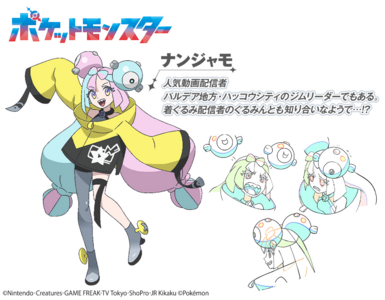
|
| A comparison of two poses from different model sheets of Arceus from Pokémon: Arceus and the Jewel of Life to best illustrate the purpose of differently colored lines and filled areas |
Iono's model sheets from Pokémon Horizons: The Series |
Storyboarding


Storyboards (Japanese: 絵コンテ e-konte, lit. "drawing continuity") are one of the earliest types of minimal production materials used for various media to allow artists to better visualize scenes that are going to be developed further, typically by background artists, modelers, animators, or a compositing team.[6][9] They often, though not always, come after model sheets in the production line. This part of Japanese productions involves a sequenced series of storyboards that include specific details to assist with the process further down the production line, including planned dialogue and acting instructions.[10]

|

|
| Storyboards from HZ012 in Pokémon Horizons: The Series, by Yoshikazu Miyao, and from Regionals in Pokémon: Path to the Peak, by Kiana Khansmith [11] | |
The next step of the storyboarding process involves creating a layout.[6][9] Now that a cut or scene has been planned out, it is up to the job of an animator to create a layout that acts as the skeleton of the scene, for artists to follow when further down in the production line. These often feature more intense detail, depth, and perspective than the initial storyboard. When compiled, layouts are often animated with rudimentary motion of specific parts in order to aid animators in the next step.[12]
Animators may also create an animatic, a sort of animated storyboard, typically with an early soundtrack or vocals, to help visualize a scene before it is fully animated.[13]
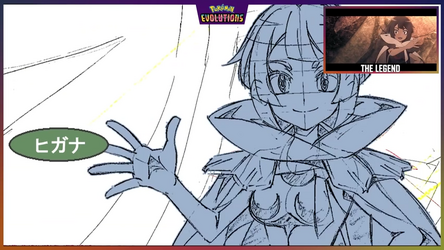
|
| Layout from The Wish in Pokémon Evolutions |
After the layout phase,[9] key frames (Japanese: 原画 genga, lit. "original pictures")[14] are used to define the motion within a cut of animation drawn by the key animator. They are often corrected by those higher up on the production team, such as animation directors[15] (also referred to as animation supervisors),[14] chief animation directors, or character designers.[6] They are then traced by in-between (Japanese: 動画 dōga, lit. "moving pictures")[14] artists, who also draw the missing frames following the notes left by the key animator for timing and frame-pacing.
Occasionally, this production material is released officially,[16][17] and in some instances, by staff on the series after their work has been completed.
As can be seen below, the color of each line or filled material represents a different intent when the artwork is to be colored. It shares these colors and their definitions with those used for model sheets.
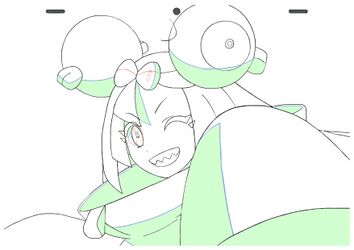
|
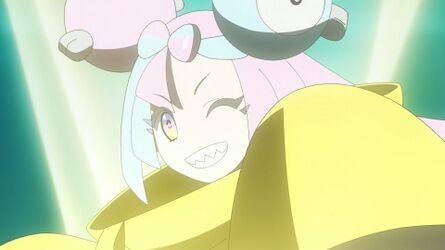
|
| Key frame from HZ015 in Pokémon Horizons: The Series by Masaaki Iwane[18] |
The finished scene in HZ015 |
A list of key frames uploaded to Bulbapedia can be found here.
Recycled animation

The bank system (Japanese: バンクシステム bank system), also known as BANK animation or just BANK, is a specific Japanese technique derived from limited animation, wherein animation is re-used in part or in whole in a 2D animated production,[19][20][21][22] whether that be direct re-use of the original animation, or by tracing existing animation to be used again.[6] For instance, Z-Moves that are used in Pokémon the Series will often look identical upon being used again, due to the complexity of the motion and camerawork involved. Occasionally, banked animation is made a little less obvious, as it can also be used to describe the re-use of animation between different Pokémon, characters, and scenes than the original animation was used for.
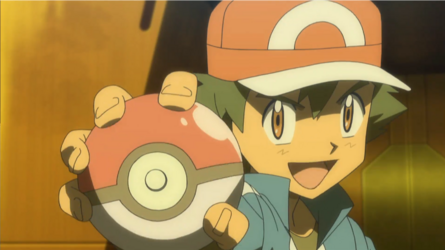
|
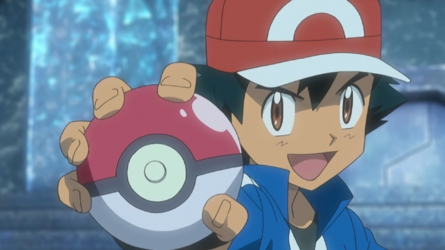
|
| Animation from The Moment of Lumiose Truth! partially reused in All Hail the Ice Battlefield! in Pokémon the Series: XY | |
Very rarely, whole content may significantly consist of banked animation, such as "recap episodes" (often produced to save time and put the project further ahead of schedule) or the fourteenth Pokémon movie (due to the choice to split one movie into two similar ones).

|

|
| Scene in Pokémon the Movie: White—Victini and Zekrom | Scene in Pokémon the Movie: Black—Victini and Reshiram |
Localization
- Main article: Dub

|
This section is incomplete. Please feel free to edit this section to add missing information and complete it. |
When bringing Pokémon animated media to other regions, it goes through a process called localization. During localization, the work's writing, visuals, audio, and language are changed to fit the target region. Pokémon animated media also tends to be dubbed, or re-voiced, in the target region's language, rather than offering the original audio with subtitles.
Since Pokémon animated media is generally targeted towards children, localization will usually remove or alter material that may be seen as objectionable or confusing to young audiences in the target region's culture. In rare cases, entire episodes may be banned from airing in certain regions due to their content. Concepts that tend to be changed include:
- Japanese text in the environment, such as on signs or buildings.
- References to Japanese culture, such as the infamous change of calling rice balls "jelly donuts".
- Puns that are heavily reliant on the Japanese language.
- References to religion.
- The appearance and use of hand-held firearms. However, unrealistically or comically large weapons such as Team Rocket's mechas tend to stay unchanged.
- Nudity and dialogue that implies nudity.
- Characters whose designs may resemble racial stereotypes. For example: Jynx's design prior to its skin becoming purple; Lenora's apron; Ash Ketchum wearing face paint to disguise as a Passimian in SM064.
In the case of Pokémon the Series, localization tends to use North America as the target region, and versions for other countries will then build off of the North American version. For instance, M02's prophecy states that the earth will "turn to ash" in the North American dub, making a pun on Ash Ketchum's name while describing devastation; but the original Japanese instead just said that the world would be destroyed[23]. In some European localizations, the pun is kept, but with a character remarking that the word used means ash in English.
Writing changes
Audio changes
Visual changes
References
- ↑ Rutenberg, Jim (January 28, 2001). "Violence Finds a Niche in Children's Cartoons". The New York Times. Archived from the original on December 24, 2021. Retrieved January 22, 2024.
- ↑ Ortiz, Lisa (June 12, 2020). "Enter Pikachu!". Pokémon Journeys: The Series. Season 23. Episode 1. Netflix. Archived from the original on February 14, 2022. Retrieved January 22, 2024.
- ↑ "10-K". Yahoo. March 31, 1999. p. 6. Archived from the original on October 5, 2016. Retrieved January 22, 2024.
- ↑ Ortiz, Lisa (June 12, 2020). "Enter Pikachu!". Pokémon Journeys: The Series. Season 23. Episode 1. Netflix. Archived from the original on February 14, 2022. Retrieved January 22, 2024.
- ↑ "5 Detective Pikachu Facts From Our Developer Interview! (What's New, Movie, & Origin)". YouTube. March 5, 2018. Archived from the original on December 21, 2021. Retrieved January 22, 2024.
- ↑ 6.0 6.1 6.2 6.3 6.4 Reference to the tags of SakugaBooru, which is the home for highly praised animation within the Japanese industry. Each tag is used to define something specific within an upload to the site, with all having an explanation on this page.
- ↑ SakugaBooru tag showing various model sheets drawn by animation staff.
- ↑ Storyboard drawn by Masaaki Iwane, posted by Yuji Asada
- ↑ 9.0 9.1 9.2 Sakugablog's glossary, which contains a variety of references from the most prominent JP animation community online
- ↑ SakugaBooru tag showing various storyboards drawn by animation staff.
- ↑ Kiana Khansmith's Path to the Peak storyboards.
- ↑ SakugaBooru tag showing various layouts drawn by animation staff.
- ↑ What is an Animatic — How To Bring Your Storyboard to Life. Brent Dunham, studiobinder.
- ↑ 14.0 14.1 14.2 Your Ultimate Guide to Anime Ending Credits: Part I -- by Kevin Cirugeda, ANN.
- ↑ Animator Hiroyuki Kitakobo referencing early use of the term Animation Director at Studio BONES.
- ↑ upload of key frame for episode 31 of Pokémon Horizons: The Series by the Japanese AniPoké Twitter account.
- ↑ upload of key frame for episode 32 of Pokémon Horizons: The Series by the Japanese AniPoké Twitter account.
- ↑ Interview with Satoshi Nakano explaining that Iwane is still a solo-animator.
- ↑ (PDF) The Ritualization of the "Bank System" in Japanese TV Animation with Hero or Heroine
- ↑ Pokémon animator Masaaki Iwane defining the term BANK on Twitter.
- ↑ Pokémon animator Masaaki Iwane using the term BANK in response to a question on Marshmallow.
- ↑ Pokémon director Hiroaki Takagi referencing the term BANK in a conversation on Twitter.
- ↑ Dogasu's Backpack - comparison of M02

|
This episode article is part of Project Anime, a Bulbapedia project that covers all aspects of Pokémon animation. |